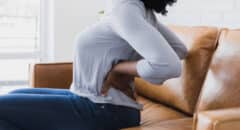 Is your back bothering you, and are you wondering how to get rid of your back pain? If the phrase "Ouch, my back!" is a regular part of your life, you're not alone: 65 million Americans suffer from back pain. Slow, gentle activity can help you live with, if not banish, tired muscles and stiff joints. Certain movements or postures aren't recommended for a weak back. Here are some suggestions for what's best for you to banish the pain.
Is your back bothering you, and are you wondering how to get rid of your back pain? If the phrase "Ouch, my back!" is a regular part of your life, you're not alone: 65 million Americans suffer from back pain. Slow, gentle activity can help you live with, if not banish, tired muscles and stiff joints. Certain movements or postures aren't recommended for a weak back. Here are some suggestions for what's best for you to banish the pain.
1. Stand Better
Standing for long periods can be stressful on your lower back. If you have to stand for work, try placing one foot on a stool or other low object. Then change feet every so often. This will help take the pressure off your lower back. Wearing cushioned shoes or standing on a thick rubber mat can also help relieve pressure when you have to stand for long hours.
2. Wear Comfortable Shoes
To help keep your back feeling healthy, choose comfortable, well-cushioned shoes. Although low-heeled shoes are best for everyday wear, heels aren’t necessarily a no-no. Choose a pair with a cushioned sole. Cushioned soles reduce the impact when you’re walking on hard surfaces. This helps protect your back, hips, and knees.
3. Start Exercise Gradually
Exercise is a great way to keep your back healthy. But if you’ve been inactive for a while, start slowly. Begin with a low-impact exercise such as walking, stationary biking, or swimming for about 30 minutes a day. Adding gentle stretching or yoga may also help your muscles. Ask your doctor what types of exercise are best for you.
4. Sit Comfortably
If your job requires you to sit for long periods, make sure your chair has a straight back, an adjustable seat, and armrests. Some people prefer more lumbar support than others. If you need extra support, place a rolled towel behind the lower part of your back. Resting your feet on a low stool can also help ease back pain when sitting.
If you spend most of your day at a computer, your work station can affect your back’s health. You shouldn’t have to lean forward to reach your keyboard or see your monitor. Instead, move them closer, so you can keep your elbows at your side as you work. You should also adjust your computer screen so it is just at or below eye level.
5. Lift Correctly
Lifting children and other heavy objects is a common source of back pain. Follow these tips to protect your back:
- Get close to the object you’re lifting. Keep your elbows... as close to your trunk as possible, trying not to reach your arms away from your body.
- Bend your knees and lift with your legs and stomach muscles.
- Don’t twist as you lift.
6. Adjust Your Driving Position
Driving long distances can put a strain on your low back. Follow these tips to help keep your back feeling good, even on the longest trips.
- Move your seat forward so you don’t have to bend to reach the steering wheel.
- Put a rolled towel, small pillow, or other lumbar support behind your lower back.
- Take a break every hour on long trips to get out of the car and walk around.
7. Push With Care
Activities that require pushing, such as vacuuming, using a stroller, and mowing the lawn can strain your lower back. Again, keep your elbows as close to your trunk as possible. Don’t push with straight arms. Choosing a lightweight stroller or vacuum can also help. If the activity still feels like too much, try doing a little at a time.
8. Choose the Best Sleep Position
Sleeping on your side is the most common sleeping position. Placing a small pillow between your knees helps keep the back in a good position. If you must sleep on your back, try using a pillow under your knees. Avoid sleeping on your stomach, as this can make back pain worse.
9. Keep Your Weight Down
Carrying extra weight on your body means more work for your lower back muscles. This is especially true if the extra pounds are around your waist. The heavier you are, the more impact there is on your back with each step. Losing weight can also help protect the muscles and joints in your knees and hips.









